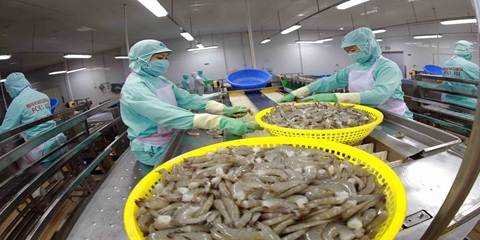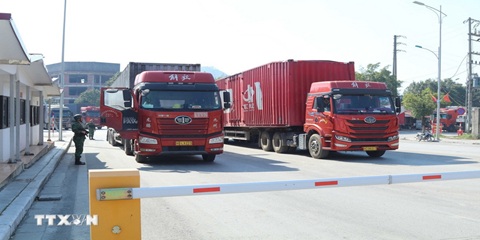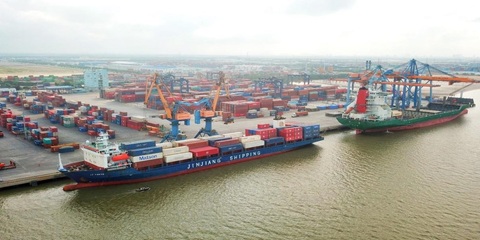Want to be in the loop?
subscribe to
our notification
Business News
GARMENT AND TEXTILE SECTOR EYES US$34 BILLION IN 2018
The textile and garment industry is projected to earn an export value of US$34 billion in 2018, second only to the telephone industry in the country, according to specialists.
More than US$1 billion exported to China
Mr Vu Duc Giang, Chairman of the Vietnam Textile and Apparel Association (VITAS), said the textile and garment industry is estimated to reach over US$31 billion in 2017, an increase of more than 10 per cent over 2016. Particularly, apparel and textile exports valued US$25.9 billion, up 8.7 per cent; yarn exports brought home US$3.5 billion, up 19.9 per cent, and fabric exports approximated US$1.1 billion. Excluding imported raw materials for domestic production, the sector enjoyed an all-time trade surplus of US$15.5 billion.
The United States, though rejecting the Trans-Pacific Partnership (TPP), still signed stateside export orders, contrary to many forecasts of falling export value, he said. Data showed the United States was still the biggest importer of Vietnamese garments and textiles, accounting for 48.3 per cent of the country’s shipments or US$12.53 billion, up 9.4 per cent against 2016.
In addition, apparel exporters actively sought new markets. While making new products for traditional markets such as ASEAN, Eastern Europe, the European Union (EU), Japan and South Korea, the Vietnamese garment and textile industry also marked an impressive milestone when its shipment value to neighbouring China amounted to US$1 billion. Moreover, according to the tariff reduction scheme of the ASEAN Trade in Goods Agreement (ATIGA) enforced in 2018, up to 99 per cent of tariff lines on imports from ASEAN-6 countries will be set at zero, thus opening up many opportunities for the Vietnamese textile and garment sector in the broad ASEAN Economic Community (AEC).
Seizing advantages of FTAs
Despite the bright future, according to many experts, the Vietnamese garment and textile industry also needs to be aware of bitter experiences in the past, like dumping accusations and the loss of yarn output in the Chinese market following policy changes there, in order to take solid steps to the future.
Mr Truong Van Cam, Vice Chairman of VITAS, said that current successes of the Vietnamese garment and textile industry come from enterprises’ quick grasping of opportunities to diversify markets. Importantly, the growth of driving big companies plays the industry-leading role. New markets of the Vietnamese garment and textile industry have been thus clearly defined on the export map in 2017, with named locations including Japan, South Korea, Russia, Africa and the Middle East.
Furthermore, to ensure sustainable development in the coming time, the textile and garment industry should pay attention to making full use of competitive advantages, mechanisms and policies of bilateral and multilateral trade agreements signed and negotiated by Vietnam. For example, the Vietnam - Eurasian Economic Union (EEU) Free Trade Agreement (including Russia, Armenia, Belarus, Kazakhstan and Kyrgyzstan) has fundamentally changed the perspective of businesses there in Vietnam. In particular, playing a pioneering role in penetrating into Russia are Nha Be Garment Corporation and Duc Giang Corporation, among others. The sector has also taken full advantage of ASEAN - Japan Comprehensive Economic Partnership Agreement (AJCEP) and the the Vietnam - Japan Economic Partnership Agreement (VJEPA).
Along with them, the Vietnam - European Union Free Trade Agreement, scheduled to come into effect in mid-2018, is expected to bring more success to the industry, according to experts. Furthermore, Vietnam’s garment and textile industry will be positively affected by ongoing FTA negotiations such as the Regional Comprehensive Economic Partnership (RCEP) Agreement between 10 ASEAN countries and six major economies (China, South Korea, Japan, India, Australia and New Zealand) and the new version of Trans-Pacific Partnership (TPP) - Comprehensive and Progressive Agreement for Trans-Pacific Partnership (CPTPP). These are foundations for policy changes creating driving force to attract foreign investment, offset sectoral shortages and sustain the future development.
Source: VCCI
Related News

VIETNAM’S SEAFOOD EXPORTS HIT OVER US$10 BILLION IN JAN-NOV
Seafood export revenue in November alone amounted to nearly US$990 million, up 6.6% year-on-year. Key product groups posted solid gains. Shrimp exports rose 11.7% to over US$385 million, supported by strong demand for whiteleg shrimp and lobster. Tra fish shipments increased 9.7% to almost US$197 million, while marine fish, squid, and mollusk exports maintained their recovery.

VIETNAM’S AGRO-FORESTRY-FISHERY EXPORTS HIT NEW RECORD IN JAN-NOV
Vietnam’s agro-forestry-fishery export revenue reached an estimated US$64.01 billion in the first 11 months of 2025, up 12.6% year-on-year and surpassing the full-year record of US$62.4 billion set in 2024. Agricultural exports reached US$34.24 billion, up 15% year-on-year, while livestock products brought in US$567.4 million, a 16.8% increase. Seafood exports rose 13.2% to US$10.38 billion, and forestry products earned US$16.61 billion, up 5.9%.

HANOI REPORTS RECORD-HIGH BUDGET REVENUE IN 2025
Hanoi’s budget revenue is estimated to reach VND641.7 trillion in 2025, the highest level ever recorded and nearly 25% above the revised target, according to a report by the municipal government. Data from the city’s socioeconomic performance review shows that total state budget collections in 2025 are projected to reach 124.9% of the adjusted plan and rise 24.9% from 2024, the Vietnam News Agency reported.

VIETNAM, CHINA TO PILOT TWO-WAY CARGO TRANSPORT AT LANG SON BORDER
Vietnam and China will launch a one-year pilot program on December 10 to allow two-way cargo transport through the Huu Nghi–Youyi Guan international border gates in Lang Son Province, reported the Vietnam News Agency. The Dong Dang-Lang Son Economic Zone Management Board said the trial aims to reduce transport costs and improve customs clearance capacity.

VIETNAM’S IMPORT-EXPORT VALUE NEARS US$840 BILLION IN JAN-NOV
The total value of Vietnam’s imports and exports was nearly US$840 billion between January and November this year, the highest level ever recorded, according to the National Statistics Office. In its latest report on the country’s socio-economic performance, the National Statistics Office highlighted a series of positive economic indicators, with trade emerging as one of the strongest drivers of growth.

OVER 19 MILLION INTERNATIONAL VISITORS COME TO VIETNAM IN JAN-NOV
Vietnam received more than 19.1 million international visitors in the first 11 months of 2025, a 20.9% increase year-on-year and the highest level ever recorded, according to the National Statistics Office. The figure surpasses the full-year record of 18 million arrivals set in 2019, before the Covid-19 pandemic. Nearly two million foreign visitors arrived in November alone, up 14.2% from October and 15.6% from the same period last year.
























